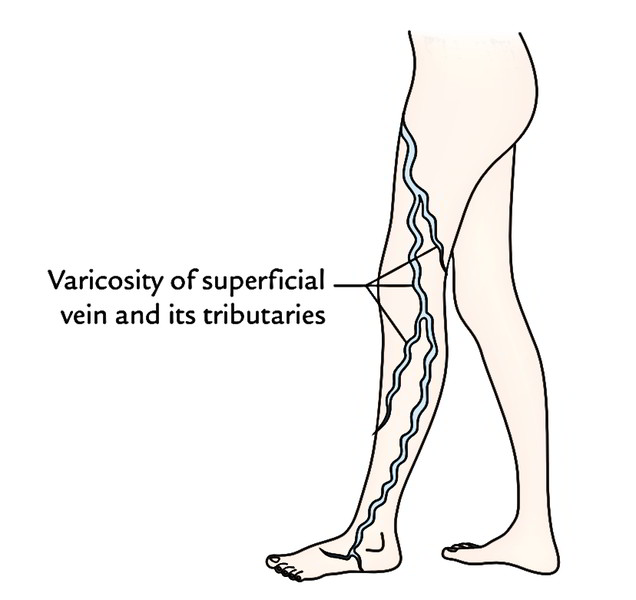Varicose Veins is the name given to those veins when the veins become swollen, dilated and tortuous.The dilatation of superficial veins and slow degeneration of their walls may result in varicose ulcers.
Due to incompetency of the valves, followed by lengthy standing (e.g bus conductors, traffic police, nurses, laboratory technicians) the superficial veins of lower limbs normally become varicosed.
- lack of effectiveness of valves in the perforating veins : valves collapse or become tightened, the veins leak due to high pressure during muscular contraction, high pressure of deep veins is transported into superficial veins. superficial veins become inflated and hurtful.
- Lack of efficiency of valves at the end of superficial veins: For example, if saphenofemoral valve becomes unequal, the great saphenous vein becomes hurtful and dilated. The varicosity commences from the saphenofemoral junction and goes slowly downwards.
Acknowledgement of sites of Incompetent Valves
The clinicians recognize the sites of incompetent valves by the following 2 evaluations: Trendelenburg test and Perthes’ test (tourniquet evaluation). Kindly note, by these evaluations only superficial veins and perforators can be examined, but not the deep veins.
Trendelenburg test
The patient is asked to is located down, and the veins are emptied by lifting the lower limb and stroking the varicose veins proximally. Now pressure is applied with the thumb at the saphenofemoral junction, and the patient is requested to stand up fast.
To check the superficial veins, the pressure is released. If the varicose veins are filled up immediately from above, it signifies incompetency of the superficial veins, and evaluation is positive. If the veins aren’t filled up, the evaluation is negative.
To check the perforating veins, the pressure at the saphenofemoral junction isn’t released, but kept for about a minute. Slow filling of the superficial veins suggests incompetency of valves of the perforating veins, enabling the blood from deep to superficial veins and evaluation is positive.
Perthes’ test (tourniquet evaluation)
It’s used to analyze the incompetence of the deep veins. A tourniquet is tied around the upper part of thigh, tight enough to occlude the saphenous vein but not the femoral vein. The patient is requested to do mild exercise, i.e., walk fast for a while, with tourniquet in place. If the perforating and deep veins are normal, the varicose veins will shrink, on the other hand if they’re obstructed, the varicose veins become more distended.
The identification of precise ssites of the faulty perforators is important before ligating such perforators. When numerous perforators are called for, the whole length of great saphenous vein is removed by stripping procedure.


 (57 votes, average: 4.90 out of 5)
(57 votes, average: 4.90 out of 5)